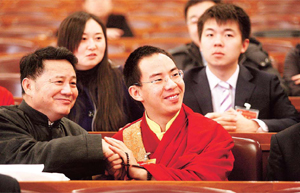Full text: Report on national economic, social development
(Xinhua)
Updated: 2010-03-16 14:14
II. Overall Requirements and Major Objectives for Economic and Social Development in 2010
This is the last year for implementing the Eleventh Five-Year Plan. Successfully completing all the work for economic and social development in 2010 is of great significance for completely countering the impact of the global financial crisis, maintaining steady and rapid economic development, accelerating transformation of the pattern of development, and laying a solid foundation for launching the Twelfth Five-Year Plan. In pursuing economic and social development in 2010, we need to fully implement the guidelines adopted at the Party's Seventeenth National Congress and the third and fourth plenary sessions of the Seventeenth Central Committee, take Deng Xiaoping Theory and the important thought of Three Represents as our guide, and thoroughly apply the Scientific Outlook on Development. We will ensure the continuity and consistency of macroeconomic policies, continue to implement a proactive fiscal policy and a moderately easy monetary policy, and strive to make our policies more targeted and flexible in light of new circumstances and new conditions. In particular, we need to attach greater importance to raising the quality and efficiency of economic growth; promoting transformation of the pattern of economic development and adjustment of the economic structure; pressing ahead with reform, opening up and independent innovation to increase the vitality and impetus of economic growth; improving people's well-being and maintaining social harmony and stability; and giving due consideration to both domestic and international situations. We need to strive to achieve steady and rapid economic development.
In view of the above overall requirements, considering the need to properly balance the relationships between maintaining steady and rapid economic development, adjusting the economic structure and managing inflation expectations, and in conformity with the Outline of the Eleventh Five-Year Plan, we have set the following major objectives for economic and social development this year.
--Maintaining steady economic growth. China's GDP will grow by about 8%. In setting this target, we have taken several major factors into account. Based on the need to expand employment, increase personal incomes, improve people's well-being and maintain social stability, it is essential to maintain a certain growth rate for the economy and it would be inappropriate to set the target too low. However, if we set a higher growth rate, not only would we have difficulty reaching it, but doing so would also strain the conditions for economic performance and put too much pressure on resources and the environment. An analysis of the conditions for development this year indicates that consumer demand should maintain steady growth, investment growth should decline but still be significant, and the import and export situation should be better than last year; therefore, the conditions exist for us to reach the target. The projected growth rate of around 8% is slightly lower than the actual growth rate last year. This figure was chosen mainly to stress that the focus of our economic work is not on a reckless pursuit of faster growth but on putting greater efforts into promoting transformation of the pattern of economic development and adjustment of the economic structure, and into improving the quality and efficiency of economic development and making our development more sustainable, so we can achieve both sound and rapid development. The target of around 8% growth serves as a guide and indicator of the anticipated growth for the country as a whole. Local governments should set their growth rates scientifically in line with their actual conditions, and never seek rapid growth at all costs, and still less raise targets at each administrative level.
--Improving the economic structure. The foundation for agricultural development will be further strengthened; emerging industries of strategic importance and service industries will develop more quickly; the value-added of primary, secondary and tertiary industries will account for 10.1%, 46.6% and 43.3% of GDP respectively; spending on R&D as a percentage of GDP will increase to at least 1.75%; positive results will be achieved in preventing haphazard and redundant development, promoting mergers and reorganizations, and eliminating backward production capacity; we will strive to reach the target set in the Eleventh Five-Year Plan for energy consumption per unit of GDP, and the discharge of major pollutants will further decrease; the urbanization rate will reach 47%, and regional development will be better balanced. Accelerating transformation of the development pattern is an inherent requirement for applying the Scientific Outlook on Development, maintaining stable and rapid economic development, and promoting social harmony and stability. This composite target is put forward to guide all sectors to make full use of both government regulation as the visible hand and market forces as the invisible hand, work hard to improve the economic structure, foster emerging industries of strategic importance quickly, eliminate backward production capacity in accordance with the law, promote enterprise transformation and upgrading, and intensify energy conservation, emissions reduction and environmental protection while consolidating the foundation for an economic turnaround. At the same time, we need to intensify efforts to balance urban and rural development and development among different regions, pick up the pace of urbanization, create new areas and poles of economic growth, and further expand domestic demand, especially consumer demand. This is the only way we can better satisfy the new expectations and new demands of the people, eliminate the tight restraints resources and the environment place on economic development, further raise the quality and efficiency of development, and seize opportunities and keep the upper hand in complex and fierce international competition.
--Ensuring and improving people's well-being. More than 9 million urban jobs will be created and the registered urban unemployment rate will stay within 4.6%; urban and rural incomes will increase steadily, with rural per capita net income rising at least 6% in real terms; all aspects of the social safety net will further improve, and work on low-income housing projects and the renewal of run-down areas will proceed more quickly; the natural population growth rate will be kept under 0.7%. Although the employment situation is grim and will remain so for some time to come, more jobs will be continuously created as the turnaround in the economy is sustained, implementation of a vigorous employment policy is intensified, and employment services and training are constantly improved. Some enterprises that have been affected by changes in the domestic and international economic environments have not fundamentally shaken off their difficulties in production and business operations, and this has reduced the number of jobs for rural migrant workers. Furthermore, the prices of agricultural products and economic returns in agriculture are on the whole too low, which has restricted the growth in rural cash income. However, as the pattern of national income distribution is gradually adjusted, policies designed to increase personal incomes are further improved, urban and rural development become better balanced, and employment channels for rural workers and the latitude for increasing rural incomes are constantly expanded, the incomes of rural residents could still rise steadily.
--Keeping overall price levels basically stable. The rise in the CPI will be around 3%. At present, China's aggregate supply exceeds aggregate demand, there is an abundant supply of almost all products, and in particular we have ample stocks of grain as a result of a succession of bumper harvests, all of which will contribute to keeping prices basically stable. However, factors that are pushing prices upward this year cannot be overlooked. They mainly include the ripple effect of price increases for major commodities on the international market, the time lag for increased domestic supplies of money and credit to work, the effects of reforms in resource taxes and the prices of resource products, and the carry-over effect of the CPI changes last year. All of these factors increase upward pressure on prices to some degree. Setting the above target will help manage inflation expectations while leaving some room for pressing ahead with reforms.
--Improving the balance of payments. Total import and export volume will increase by about 8%, the trade surplus will shrink, and trade in services will develop more quickly; we will make better use of foreign capital and improve the trade mix; Chinese investment overseas will expand steadily and return higher profits. Stabilizing and expanding foreign demand while working hard to expand domestic demand will be conducive for making better use of both domestic and international resources and markets and for creating more jobs, and competing internationally will promote structural improvement and raise the quality of development. Although the international economic environment is still grim and complex and trade protectionism is on the resurgence, the global economic and trade situation this year will be better than last year if no major unexpected disruptions happen. In addition, there was a significant drop in our exports and imports in 2009, so the relevant base figures are relatively low. Consequently, as long as we grasp the favorable opportunities presented by the readjustment in the global division of labor; make the most of our comparative advantages; quickly change the way our external economy develops; adhere to the path of competing on quality and efficiency and diversifying export markets; and constantly raise the international competitiveness and risk resistance of our economy, we will be able to revive the growth of our foreign trade.
On the basis of the above arrangements and in conformity with the Outline of the Eleventh Five-Year Plan, we expect that by the end of this year, we will reach or exceed most of our targets set in the Plan, including those for economic growth, urban job creation, urban and rural incomes, the coverage of the new type of rural cooperative medical care system, the number of urban residents covered by the basic old-age insurance, the discharge of major pollutants and the rate of urbanization. However, we still need to work harder to meet the targets for energy consumption per unit of GDP and spending on R&D as a percentage of GDP.


